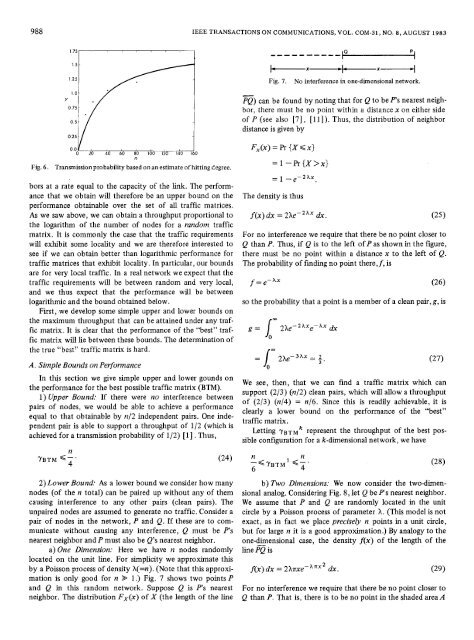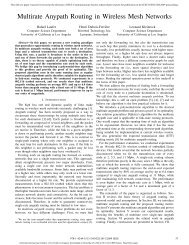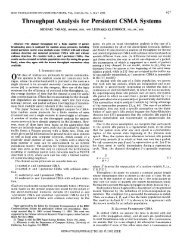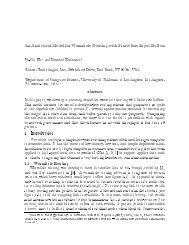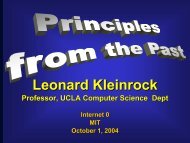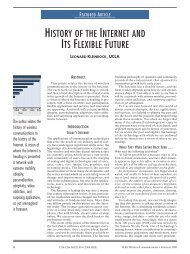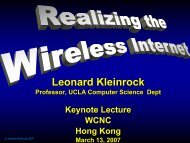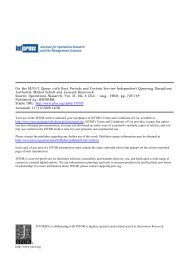On the Capacity of Single-Hop Slotted ALOHA - IEEE Xplore
On the Capacity of Single-Hop Slotted ALOHA - IEEE Xplore
On the Capacity of Single-Hop Slotted ALOHA - IEEE Xplore
You also want an ePaper? Increase the reach of your titles
YUMPU automatically turns print PDFs into web optimized ePapers that Google loves.
988 <strong>IEEE</strong> TRANSACTIONS ON COMMUNICATIONS, VOL. COM-31, NO. 0, AUGUST 1983+ x b x +Fig. 7.No interference in one-dimensional network.0751 . /""/ 0 25oooLio 40 60 io IO0 120 Id0 doFig. 6. Transnissionprobability based onan estimate <strong>of</strong>hitting degree.bors at a rate equal to <strong>the</strong> capacity <strong>of</strong> <strong>the</strong> link. The performancethat we obtain will <strong>the</strong>refore be an upper bound on <strong>the</strong>performance obtainable over <strong>the</strong> set <strong>of</strong> all traffic matrices.As we saw above, we can obtain a throughput proportional to<strong>the</strong> logarithm <strong>of</strong> <strong>the</strong> number <strong>of</strong> nodes for a random trafficmatrix. It is commonly <strong>the</strong> case that <strong>the</strong> traffic requirementswill exhibit some locality and we are <strong>the</strong>refore interested tosee if we can obtain better than logarithmic performance fortraffic matrices that exhibit locality. In particular, our boundsare for very local traffic. In a real network we expect that <strong>the</strong>traffic requirements will be between random and very local,and we thus expect that <strong>the</strong> performance will be betweenlogarithmic and <strong>the</strong> bound obtained below.First, we develop some simple upper and lower bounds on<strong>the</strong> maximum throughput that can be attained under any trafficmatrix. It is clear that <strong>the</strong> performance <strong>of</strong> <strong>the</strong> "best" trafficmatrix will lie between <strong>the</strong>se bounds. The determination <strong>of</strong><strong>the</strong> true "best" traffic matrix is hard.A. Simple Bounds on PerformanceIn this section we give simple upper and lower gounds on<strong>the</strong> performance for <strong>the</strong> best possible traffic matrix (BTM).1) Upper Bound: If <strong>the</strong>re were no interference betweenpairs <strong>of</strong> nodes, we would be able to achieve a performanceequal to that obtainable by n/2 independent pairs. <strong>On</strong>e independentpair is able to support a throughput <strong>of</strong> 1/2 (which isachieved for a transmission probability <strong>of</strong> 1/2) [ 1 ] . Thus,i@) can be found by noting that for Q to be P's nearest neighbor,<strong>the</strong>re must be no point within a distance x on ei<strong>the</strong>r side<strong>of</strong> P (see also [7], [ll]). Thus, <strong>the</strong> distribution <strong>of</strong> neighbordistance is given byFx(x) = Pr {XQX}= 1 -Pr{X>x}- 1 -,-2hx,The density is thusf(x) dx = 2Ae-2hx dx. (25)For no interference we require that <strong>the</strong>re be no point closer toQ than P. Thus, if Q is to <strong>the</strong> left <strong>of</strong>P as shown in <strong>the</strong> figure,<strong>the</strong>re must be no point within a distance x to <strong>the</strong> left <strong>of</strong> Q.The probability <strong>of</strong> finding no point <strong>the</strong>re, f, isso <strong>the</strong> probability that a point is a member <strong>of</strong> a clean pair,g, isWe see, <strong>the</strong>n, that we can find a traffic matrix which cansupport (2/3) (n/2) clean pairs, which will allow a throughput<strong>of</strong> (2/3) (44) = n/6. Since this is readily achievable, it isclearly a lower bound on <strong>the</strong> Performance <strong>of</strong> <strong>the</strong> "best"traffic matrix.Letting yBTMk represent <strong>the</strong> throughput <strong>of</strong> <strong>the</strong> best possibleconfiguration for a k-dimensional network, we have2) Lower Bound: As a lower bound we consider how manynodes (<strong>of</strong> <strong>the</strong> n total) can be paired up without any <strong>of</strong> <strong>the</strong>mcausing interference to any o<strong>the</strong>r pairs (clean pairs). Theunpaired nodes are assumed to generate no traffic. Consider apair <strong>of</strong> nodes in <strong>the</strong> network, P and Q. If <strong>the</strong>se are to communicatewithout causing any interference, Q must be P'snearest neighbor and P must also be Q's nearest neighbor.a) <strong>On</strong>e Dimension: Here we have n nodes randomlylocated on <strong>the</strong> unit line. For simpficity we approximate thisby a Poisson process <strong>of</strong> density A(=n). (Note that this approximationis only good for n % 1 .) Fig. 7 shows two points Pand Q in this random network. Suppose Q is P's nearestneighbor. The distribution Fx(x) <strong>of</strong> X (<strong>the</strong> length <strong>of</strong> <strong>the</strong> lineb) Two Dimensions: We now consider <strong>the</strong> two-dimensionalanalog. Considering Fig. 8, let Q be P s nearest neighbor.We assume that P and Q are randomly located in <strong>the</strong> unitcircle by a Poisson process <strong>of</strong> parameter A. (This model is notexact, as in fact we place precisely n points in a unit circle,but for large n it is a good approximation.) By analogy to <strong>the</strong>one-dimensional case, <strong>the</strong> density f(x) <strong>of</strong> <strong>the</strong> length <strong>of</strong> <strong>the</strong>line ~2 isf(x) dx = 2Arr~e-~"~~ dx. (29)For no interference we require that <strong>the</strong>re be no point closer toQ than P. nat is, <strong>the</strong>re is to be no point in <strong>the</strong> shaded area A


